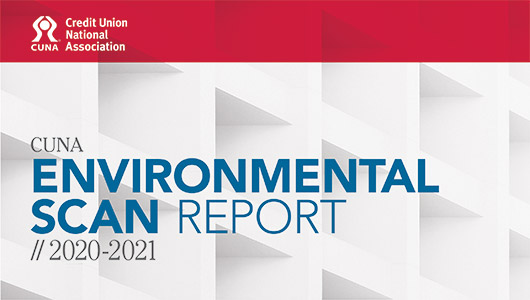
Reshaping service strategies: 5 issues to consider
CUNA Environmental Scan offers insights into resuming ‘normal’ business operations.
Attorney David Reed, partner with Reed and Jolly, delivered this advice to credit unions during a CUNA compliance roundtable about returning to work amid the coronavirus (COVID-19) pandemic:
Being comfortable with uncertainty will be a part of your operations and strategic planning for some time to come.
No one had “respond to a global pandemic” at the top of their to-do list in January 2020. Yet that’s what credit unions faced not even one quarter into this year.
And while most credit unions had detailed plans for business continuity regardless of the disaster, the length of the current pandemic—with no vaccine in sight—makes any plan a day-to-day challenge.
While “normal business operations during a global pandemic” continues to take shape, your vision of improving members’ financial lives is clear.
The 2020-2021 CUNA Environmental Scan offers critical issues and questions to consider as you reshape your service strategies, including:
• Legislative relief packages and increasing compliance responsibilities. Congress delivered economic packages with stimulus payments for members and programs to support employees and businesses. More proposals might be in the works.
These new regulations produced an onslaught of new compliance duties to the tune of 24 NCUA letters or risks alerts and 22 interim final rules (so far) by the Small Business Administration.
How will you sharpen your advocacy awareness and manage these additional compliance requirements?
• Operations and culture. You’ve already transformed numerous processes and employee roles due to branch closures, safety concerns, and new regulations.
As branches reopen to members, safety and soundness remain primary.
How many of these changes will be permanent? How has your workplace culture evolved? Will consumer behavior influence even more change?
• The gig economy and vulnerable members. Gig workers make up an estimated 25% to 35% of the workforce. But COVID-19’s impacts are exposing the vulnerability of this cohort to economic downturns or recessions.
Many will see their income decline as demand for their services and products dries up, while their lack of access to paid sick leave and employer-sponsored health insurance compounds their vulnerability.
According to the Kaiser Family Foundation, 31% of Americans say they’ve experienced problems making rent or mortgage payments, or paying for food, utilities, credit card bills, or medical costs as a result of the coronavirus.
That number climbs to 48% among Blacks and 46% among Latinos.
How do your products and services keep these workers and other vulnerable members financially healthy?
• Digital transformation. From board governance to virtual teams to contactless payments and lending, digital services have become must-have for credit unions of all shapes and sizes since the pandemic.
Through collaboration and partnerships, many have advanced their digital road maps without missing a beat. And those who haven’t must consider the impact of not doing so.
How do you maintain these efficiencies and continue to build members’ trust and loyalty through digital services?
• Artificial intelligence (AI) capabilities. You will need deep business insights as you chart a course through an uncertain future and build a culture of service.
The pandemic requires businesses to lean on AI capabilities to provide safe work environments via contact tracing or increased screening, to quickly respond to economic factors, and to understand members’ financial situations.
How can you use AI to strengthen member engagement?
ANN HAYES PETERSON is vice president of publishing and editor-in-chief at Credit Union National Association.
